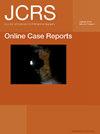Corneal topographic changes after sequential suture removal in a corneal wound burn after phacoemulsification
Q4 Medicine
引用次数: 0
Abstract
Three sutures placed in a 2.8 mm clear corneal incision after wound burn in phacoemulsification, and their sequential removal at 1 month, the resultant corneal topographic changes, and refraction documented immediately have not been reported, making this case report unique. This case describes the timing of suture removal and stabilization of refraction in a case of corneal wound burn associated with phacoemulsification. A 70-year-old woman presented with diminution of visio in both eyes for 1 year. O/E lens opacification classification system grade NC4C3P2 cataract was present in both eyes with normal fundus. Primary diagnosis was cataract in both eyes. The left eye was planned for microincision cataract surgery by a trainee under local anesthesia. Corneal wound burn and iris chaffing were noted at the end of surgery, and 3 sutures were placed at the main port. At 15 days and 1 month postoperatively, the uncorrected distance visual acuity (UDVA) was 20/80 with high regular astigmatism showing over cylinder on autorefractometer. Sequential suture removal was done 1 month postoperatively with an interval of 15 minutes between each suture and corneal topography performed after each suture removal. Topography exhibited reduction in astigmatism from 10.6 to 1.2 diopters after suture removal. The UDVA and corrected distance visual acuity after 1-hour postsuture removal was 20/32 and 20/20, respectively, with a refraction of −0.50 diopter sphere/−0.50 diopter cylinder @ 95 degrees, which was stable even at 1-month and 6-month follow-up. We conclude that suture removal can be planned as early as 4 weeks with refraction and keratometric readings being stable even after 6 months.超声乳化术后角膜创面烧伤顺序缝线拆除后角膜地形图的变化
白内障超声乳化术中伤口烧伤后,在2.8 mm透明角膜切口中放置三条缝线,并在1个月时连续取出,由此产生的角膜地形变化和折射率立即记录,目前尚未报道,这使得本病例报告具有独特性。本病例描述了白内障超声乳化术后角膜伤口烧伤的缝线取出时间和屈光稳定。一位70岁的女性双眼视力下降,持续1年。O/E晶状体混浊分级系统NC4C3P2级白内障出现在眼底正常的双眼中。初步诊断为双眼白内障。左眼计划由一名受训人员在局部麻醉下进行微创白内障手术。术后15天和1个月,裸眼远视力(UDVA)为20/80,自动验光仪上显示高度规则散光。术后1个月进行连续缝线移除,每次缝线与每次缝线移除后进行的角膜地形图之间的间隔为15分钟。地形图显示缝线移除后散光从10.6屈光度减少到1.2屈光度。术后1小时的UDVA和矫正远视敏锐度分别为20/32和20/20,在95度时的屈光度为−0.50屈光球/−0.50屈光柱,即使在1个月和6个月的随访中也是稳定的。我们得出的结论是,缝线最早可以计划在4周内取出,即使在6个月后,屈光度和角膜测量读数也保持稳定。
本文章由计算机程序翻译,如有差异,请以英文原文为准。
求助全文
约1分钟内获得全文
求助全文

 求助内容:
求助内容: 应助结果提醒方式:
应助结果提醒方式:


